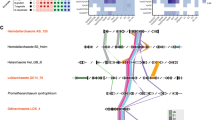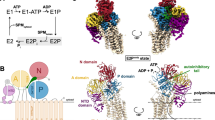Abstract
The AAA+ ATPases are essential for various activities such as membrane trafficking, organelle biogenesis, DNA replication, intracellular locomotion, cytoskeletal remodelling, protein folding and proteolysis1. The AAA ATPase Vps4, which is central to endosomal traffic to lysosomes2,3, retroviral budding4 and cytokinesis5, dissociates ESCRT complexes (the endosomal sorting complexes required for transport) from membranes6,7,8,9,10,11,12,13,14,15. Here we show that, of the six ESCRT--related subunits in yeast, only Vps2 and Did2 bind the MIT (microtubule interacting and transport) domain of Vps4, and that the carboxy-terminal 30 residues of the subunits are both necessary and sufficient for interaction. We determined the crystal structure of the Vps2 C terminus in a complex with the Vps4 MIT domain, explaining the basis for selective ESCRT-III recognition. MIT helices α2 and α3 recognize a (D/E)xxLxxRLxxL(K/R) motif, and mutations within this motif cause sorting defects in yeast. Our crystal structure of the amino-terminal domain of an archaeal AAA ATPase of unknown function shows that it is closely related to the MIT domain of Vps4. The archaeal ATPase interacts with an archaeal ESCRT-III-like protein even though these organisms have no endomembrane system, suggesting that the Vps4/ESCRT-III partnership is a relic of a function that pre-dates the divergence of eukaryotes and Archaea.
This is a preview of subscription content, access via your institution
Access options
Subscribe to this journal
Receive 51 print issues and online access
$199.00 per year
only $3.90 per issue
Buy this article
- Purchase on Springer Link
- Instant access to full article PDF
Prices may be subject to local taxes which are calculated during checkout




Similar content being viewed by others
References
Ogura, T. & Wilkinson, A. J. AAA+ superfamily ATPases: common structure—diverse function. Genes Cells 6, 575–597 (2001)
Slagsvold, T., Pattni, K., Malerod, L. & Stenmark, H. Endosomal and non-endosomal functions of ESCRT proteins. Trends Cell Biol. 16, 317–326 (2006)
Williams, R. L. & Urbe, S. The emerging shape of the ESCRT machinery. Nature Rev. Mol. Cell Biol. 8, 355–368 (2007)
Bieniasz, P. D. Late budding domains and host proteins in enveloped virus release. Virology 344, 55–63 (2006)
Carlton, J. G. & Martin-Serrano, J. Parallels between cytokinesis and retroviral budding: a role for the ESCRT machinery. Science 316, 1908–1912 (2007)
Nickerson, D. P., West, M. & Odorizzi, G. Did2 coordinates Vps4-mediated dissociation of ESCRT-III from endosomes. J. Cell Biol. 175, 715–720 (2006)
Babst, M., Wendland, B., Estepa, E. J. & Emr, S. D. The Vps4p AAA ATPase regulates membrane association of a Vps protein complex required for normal endosome function. EMBO J. 17, 2982–2993 (1998)
Howard, T. L., Stauffer, D. R., Degnin, C. R. & Hollenberg, S. M. CHMP1 functions as a member of a newly defined family of vesicle trafficking proteins. J. Cell Sci. 114, 2395–2404 (2001)
Amerik, A., Nowak, J., Swaminathan, S. & Hochstrasser, M. The Doa4 deubiquitinating enzyme is functionally linked to the vacuolar protein-sorting and endocytic pathways. Mol. Biol. Cell 11, 3365–3380 (2000)
Tsang, H. T. et al. A systematic analysis of human CHMP protein interactions: Additional MIT domain-containing proteins bind to multiple components of the human ESCRT III complex. Genomics 88, 333–346 (2006)
von Schwedler, U. K. et al. The protein network of HIV budding. Cell 114, 701–713 (2003)
Bowers, K. et al. Protein–protein interactions of ESCRT complexes in the yeast Saccharomyces cerevisiae . Traffic 5, 194–210 (2004)
Martin-Serrano, J., Yarovoy, A., Perez-Caballero, D. & Bieniasz, P. D. Divergent retroviral late-budding domains recruit vacuolar protein sorting factors by using alternative adaptor proteins. Proc. Natl Acad. Sci. USA 100, 12414–12419 (2003)
Vajjhala, P. R., Catchpoole, E., Nguyen, C. H., Kistler, C. & Munn, A. L. Vps4 regulates a subset of protein interactions at the multivesicular endosome. FEBS J. 274, 1894–1907 (2007)
Scott, A. et al. Structure and ESCRT-III protein interactions of the MIT domain of human VPS4A. Proc. Natl Acad. Sci. USA 102, 13813–13818 (2005)
Bishop, N. & Woodman, P. ATPase-defective mammalian VPS4 localizes to aberrant endosomes and impairs cholesterol trafficking. Mol. Biol. Cell 11, 227–239 (2000)
Scott, A. et al. Structural and mechanistic studies of VPS4 proteins. EMBO J. 24, 3658–3669 (2005)
Babst, M., Katzmann, D. J., Estepa-Sabal, E. J., Meerloo, T. & Emr, S. D. ESCRT-III: an endosome-associated heterooligomeric protein complex required for MVB sorting. Dev. Cell 3, 271–282 (2002)
Muziol, T. et al. Structural basis for budding by the ESCRT-III factor CHMP3. Dev. Cell 10, 821–830 (2006)
Lin, Y., Kimpler, L. A., Naismith, T. V., Lauer, J. M. & Hanson, P. I. Interaction of the mammalian endosomal sorting complex required for transport (ESCRT) III protein hSnf7-1 with itself, membranes, and the AAA+ ATPase SKD1. J. Biol. Chem. 280, 12799–12809 (2005)
Zamborlini, A. et al. Release of autoinhibition converts ESCRT-III components into potent inhibitors of HIV-1 budding. Proc. Natl Acad. Sci. USA 103, 19140–19145 (2006)
Agromayor, M. & Martin-Serrano, J. Interaction of AMSH with ESCRT-III and deubiquitination of endosomal cargo. J. Biol. Chem. 281, 23083–23091 (2006)
McCullough, J. et al. Activation of the endosome-associated ubiquitin isopeptidase AMSH by STAM, a component of the multivesicular body-sorting machinery. Curr. Biol. 16, 160–165 (2006)
Whitley, P. et al. Identification of mammalian Vps24p as an effector of phosphatidylinositol 3,5-bisphosphate-dependent endosome compartmentalization. J. Biol. Chem. 278, 38786–38795 (2003)
Yorikawa, C. et al. Human CHMP6, a myristoylated ESCRT-III protein, interacts directly with an ESCRT-II component EAP20 and regulates endosomal cargo sorting. Biochem. J. 387, 17–26 (2005)
Takasu, H. et al. Structural characterization of the MIT domain from human Vps4b. Biochem. Biophys. Res. Commun. 334, 460–465 (2005)
Scheuring, S. et al. Mammalian cells express two VPS4 proteins both of which are involved in intracellular protein trafficking. J. Mol. Biol. 312, 469–480 (2001)
Reid, E. et al. The hereditary spastic paraplegia protein spastin interacts with the ESCRT-III complex-associated endosomal protein CHMP1B. Hum. Mol. Genet. 14, 19–38 (2005)
Field, M. C., Gabernet-Castello, C. & Dacks, J. B. in Origins and Evolution of Eukaryotic Endomembranes and Cytoskeleton (ed. Jékely, G.) 84–96 (Eurekah/Landes Bioscience Press, Austin, TX, 2007)
Hartman, J. J. & Vale, R. D. Microtubule disassembly by ATP-dependent oligomerization of the AAA enzyme katanin. Science 286, 782–785 (1999)
Acknowledgements
We thank M. Babu for advice on the archaeal genome analysis. We acknowledge the European Synchrotron Radiation Facility for provision of synchrotron radiation facilities and we thank G. Cioci, D. Flot, I. Leiros and G. Leonard for assistance in using beamlines ID23-2 and ID23-1. T.O. was supported by a JSPS fellowship and S.S. by a fellowship from the Howard Hughes Medical Institute. This research was supported by the Howard Hughes Medical Institute (S.D.E.) and the Medical Research Council (R.L.W.).
The atomic coordinates of the yeast Vps2–Vps4 MIT-domain complex and the S. solfataricus MIT domain are deposited in the Protein Data Bank under accession numbers 2V6X and 2V6Y, respectively.
Author information
Authors and Affiliations
Corresponding author
Ethics declarations
Competing interests
The authors declare no competing financial interests.
Supplementary information
Supplementary Information
The file contains Supplementary Tables 1-2, Supplementary Figures 1-2 with Legends, Supplementary Methods and additional references. Supplementary Tables 1 and 2 provide detailed statistics for the crystallographic structures. Supplementary Figure 1 provides a schematic of the process of Vps4-mediated disassembly of ESCRT-III lattices. Supplementary Figure 2 provides a dendrogram for archaeal ESCRT-III-like sequences and highlights the group of sequences that occur adjacent to the Vps4-like ATPase. (PDF 1324 kb)
Rights and permissions
About this article
Cite this article
Obita, T., Saksena, S., Ghazi-Tabatabai, S. et al. Structural basis for selective recognition of ESCRT-III by the AAA ATPase Vps4. Nature 449, 735–739 (2007). https://doi.org/10.1038/nature06171
Received:
Accepted:
Issue Date:
DOI: https://doi.org/10.1038/nature06171
This article is cited by
-
Lem2 and Lnp1 maintain the membrane boundary between the nuclear envelope and endoplasmic reticulum
Communications Biology (2020)
-
Prokaryotic cytoskeletons: protein filaments organizing small cells
Nature Reviews Microbiology (2018)
-
Genomic inference of the metabolism and evolution of the archaeal phylum Aigarchaeota
Nature Communications (2018)
-
Reverse-topology membrane scission by the ESCRT proteins
Nature Reviews Molecular Cell Biology (2017)
-
Structural basis of katanin p60:p80 complex formation
Scientific Reports (2017)
Comments
By submitting a comment you agree to abide by our Terms and Community Guidelines. If you find something abusive or that does not comply with our terms or guidelines please flag it as inappropriate.



